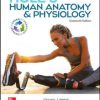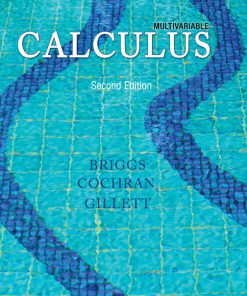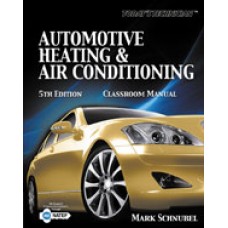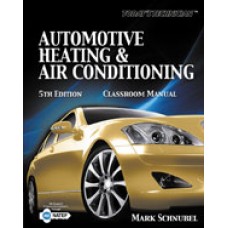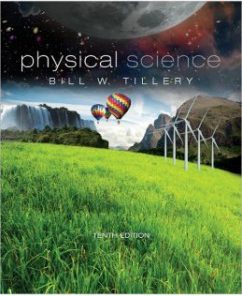Test Bank for Refrigeration and Air Conditioning Technology, 9th Edition, Eugene Silberstein, Jason Obrzut, John Tomczyk, Bill Whitman, Bill Johnson
$55.00 Original price was: $55.00.$29.99Current price is: $29.99.
Test Bank for Refrigeration and Air Conditioning Technology, 9th Edition, Eugene Silberstein, Jason Obrzut, John Tomczyk, Bill Whitman, Bill Johnson
Instant download Test Bank for Refrigeration and Air Conditioning Technology, 9th Edition, Eugene Silberstein, Jason Obrzut, John Tomczyk, Bill Whitman, Bill Johnson pdf docx epub after payment.
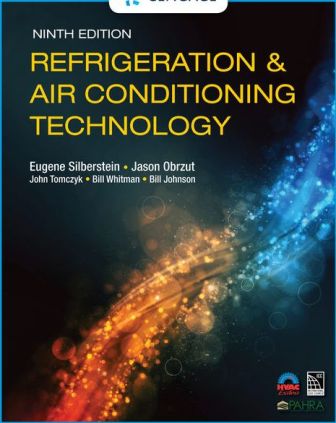
Product details:
- ISBN-10 : 0357122275
- ISBN-13 : 978-0357122273
- Author: John Tomczyk; Jason Obrzut
Develop the knowledge and skills you need to maintain and troubleshoot today�s complex heating, air conditioning, and refrigeration systems with REFRIGERATION & AIR CONDITIONING TECHNOLOGY, Ninth Edition. This best-selling, easy-to-understand resource provides hands-on guidance, practical applications, and the solid foundation you need to understand modern HVAC service and repair, its environmental challenges, and their solutions. Focused on sustainable technology and emphasizing new technologies and green awareness, the Ninth Edition features the latest advances in the HVAC/R industry, including updated content throughout the text and more than 400 new and revised figures and images. Drawing on decades of industry experience, the authors also cover the all-important soft skills and customer relations issues that today’s professionals need to master for career success. Memorable real-world examples, hundreds of vibrant photos, and unique Service Call features bring key concepts to life and help you develop the knowledge and skills to succeed in today’s dynamic industry.
Table of contents:
- Section 1: Theory of Heat
- Introduction
- History of Refrigeration and Air-Conditioning (Cooling)
- Green Awareness
- History of Home and Commercial Heating
- Career Opportunities
- Technician Certification Programs
- Programmatic Accreditation
- National Skill Standards
- Customer Relations and Technician Soft Skills
- Unit 1: Heat, Temperature, and Pressure
- 1.1 Heat, Temperature, and Pressure
- 1.2 Temperature
- 1.3 Introduction to Heat
- 1.4 Conduction
- 1.5 Convection
- 1.6 Radiation
- 1.7 Sensible Heat
- 1.8 Latent Heat
- 1.9 Specific Heat
- 1.10 Sizing Heating Equipment
- 1.11 Pressure
- 1.12 Atmospheric Pressure
- 1.13 Pressure Gauges
- Unit 2: Matter and Energy
- 2.1 Matter
- 2.2 Mass and Weight
- 2.3 Density
- 2.4 Specific Gravity
- 2.5 Specific Volume
- 2.6 Gas Laws
- 2.7 Energy
- 2.8 Conservation of Energy
- 2.9 Thermal Energy
- 2.10 Energy in Magnetism
- 2.11 Purchase of Energy
- 2.12 Energy Used as Work
- 2.13 Power
- 2.14 Electrical Power – The Watt
- Unit 3: Refrigeration and Refrigerants
- 3.1 Introduction to Refrigeration
- 3.2 Refrigeration
- 3.3 Rating Refrigeration Equipment
- 3.4 The Refrigeration Process
- 3.5 Temperature and Pressure Relationship
- 3.6 Basic Refrigeration System Components
- 3.7 The Evaporator
- 3.8 The Compressor
- 3.9 The Condenser
- 3.10 The Refrigerant Metering Device
- 3.11 A High-Temperature, Matched Refrigeration System by the Numbers
- 3.12 Refrigerants
- 3.13 Refrigerants Must Be Safe
- 3.14 Refrigerants Must Be Detectable
- 3.15 The Boiling Point of the Refrigerant
- 3.16 Pumping Characteristics
- 3.17 Popular Refrigerants and Their Important Characteristics
- 3.18 Refrigerant Cylinder Color Codes
- 3.19 Recovery, Recycling, and Reclaiming of Refrigerants
- 3.20 Plotting the Refrigeration Cycle
- 3.21 Plotting the Refrigeration Cycle for Blends with Noticeable Temperature Glide (Zeotropic Blends
- Section 2: Safety, Tools and Equipment, and Shop Practices
- Unit 4: General Safety Practices
- 4.1 Workplace Surroundings and Personal Protective Equipment (PPE)
- 4.2 Pressurized Vessels, Piping, and Systems
- 4.3 Electrical Safety
- 4.4 First Aid
- 4.5 Ladder Safety
- 4.6 Heat
- 4.7 Cold
- 4.8 Mechanical Equipment
- 4.9 Moving Heavy Objects
- 4.10 Refrigerants in Your Breathing Space
- 4.11 Using Chemicals
- Unit 5: Tools, Instrumentation, and Equipment
- 5.1 Introduction to Tools, Instrumentation, and Equipment
- 5.2 Hand Tools
- 5.3 Power Tools
- 5.4 Electrical Test Instruments
- 5.5 Refrigerant Leak Detectors
- 5.6 Tubing Tools
- 5.7 Piping Tools
- 5.8 Sheet Metal Tools
- 5.9 HVACR Installation and Service Tools and Equipment
- 5.10 Airside Instrumentation
- 5.11 Combustion Testing Equipment
- 5.12 Energy Auditing Instrumentation
- Unit 6: Fasteners
- 6.1 Nails
- 6.2 Staples and Rivets
- 6.3 Screws
- 6.4 Hollow Wall Fasteners
- 6.5 Concrete Fasteners
- 6.6 Threaded Rod
- 6.7 Piping and Ductwork Fasteners
- 6.8 Pins, Clamps, and Rings
- 6.9 Electrical Fasteners
- Unit 7: Tubing and Piping
- 7.1 Purpose of Tubing and Piping
- 7.2 Types and Sizes of Tubing
- 7.3 Tubing Insulation
- 7.4 Line Sets
- 7.5 Cutting Tubing
- 7.6 Bending Tubing
- 7.7 Soldering and Brazing Processes
- 7.8 Heat Sources for Soldering and Brazing
- 7.9 Fluxing
- 7.10 Soldering Techniques
- 7.11 Brazing Techniques
- 7.12 Practical Soldering and Brazing Tips
- 7.13 Making Flare Joints
- 7.14 Swaging Techniques
- 7.15 Compression Fittings
- 7.16 Steel and Wrought Iron Pipe
- 7.17 Installing Steel Pipe
- 7.18 Plastic Pipe
- 7.19 Alternative Mechanical Piping Connections
- Unit 8: Leak Detection, System Evacuation, and System Cleanup
- 8.1 Leaks
- 8.2 Basic Refrigerant Leak Detection
- 8.3 Advanced Leak Detection
- 8.4 Standing Pressure Test
- 8.5 Leak Detection Tips
- 8.6 Repairing Leaks
- 8.7 System Evacuation
- 8.8 General Evacuation Procedures
- 8.9 Cleaning a Dirty System
- Unit 9: Refrigerant and Oil Chemistry and Management – Recovery, Recycling, Reclaiming, and Retrofit
- 9.1 Refrigerants and the Environment
- 9.2 Ozone Depletion
- 9.3 Global Warming
- 9.4 Refrigerants
- 9.5 CFC Refrigerants
- 9.6 HCFC Refrigerants
- 9.7 HFC Refrigerants
- 9.8 Hydrofluoro-Olefin (HFO) Refrigerants
- 9.9 Hydrocarbon (HC) Refrigerants
- 9.10 Refrigerant Numbering
- 9.11 Refrigerant Blends
- 9.12 Popular Refrigerants and Their Compatible Oils
- 9.13 Refrigerant Oils and Their Applications
- 9.14 Regulations
- 9.15 Recover, Recycle, or Reclaim
- 9.16 Methods of Recovery
- 9.17 Mechanical Recovery Systems
- 9.18 Recovering Refrigerant from Small Appliances
- 9.19 Reclaiming Refrigerant
- 9.20 Refrigerant Retrofitting
- Unit 10: System Charging
- 10.1 Charging a Refrigeration System
- 10.2 Vapor Refrigerant Charging
- 10.3 Liquid Refrigerant Charging
- 10.4 Weighing Refrigerant
- 10.5 Graduated Charging Cylinders
- 10.6 Charging Charts
- 10.7 Subcooling Charging Method for TXV Systems
- 10.8 Charging Near-Azeotropic (Zeotropic) Refrigerant Blends
People also search:
Refrigeration and Air Conditioning Technology, 9th Edition
Refrigeration and Air Conditioning Technology, 9th Edition pdf
Refrigeration and Air Conditioning Technology
refrigeration and air conditioning technology unit 12 review questions
refrigeration and air conditioning technology unit 43 review questions
You may also like…
Solution Manual
Solution Manual
Solution Manual
Commercial Refrigeration for Air Conditioning Technicians 3rd Edition Wirz Solutions Manual



